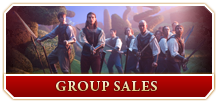At first glance Lewis was, perhaps, an unlikely person to have crafted highly regarded works of fantasy. A brilliant academic, he was educated at Oxford University, and returned there following service in World War I to become a Fellow and Tutor of English Literature at Magdalen College. Later, in 1954, he was appointed to the Chair of Medieval and Renaissance Literature at Magdalene College, Cambridge University.
But Lewis had loved fantasy literature since his early years, and was then deeply influenced by his reading of George MacDonald’s great imaginative tale Phantastes. “I knew that I had crossed a great frontier,” he would later write.
Still earlier, as a boy, he had created Boxen—an imaginary world where animals talked and had adventures. As an adult, Lewis’s scholarly studies were steeped in chivalric literature and medieval legends. Lastly, he was highly favored in that he had a decades-long friendship with J.R.R. Tolkien, the creator of The Hobbit and The Lord of the Rings. There were other influences upon him, but these aspects of his life proved crucial catalysts for him to pen the Chronicles of Narnia.
 What are the Chronicles? In brief, they are seven works of fantasy written for children and published between 1950 and 1956. They are, in terms of the order in which Lewis wished them to be read: The Magician’s Nephew (1955), The Lion, the Witch and the Wardrobe (1950), The Horse and his Boy (1954), Prince Caspian (1951), The Voyage of the ‘Dawn Treader’ (1952), The Silver Chair (1953), and The Last Battle (1956).[5]
What are the Chronicles? In brief, they are seven works of fantasy written for children and published between 1950 and 1956. They are, in terms of the order in which Lewis wished them to be read: The Magician’s Nephew (1955), The Lion, the Witch and the Wardrobe (1950), The Horse and his Boy (1954), Prince Caspian (1951), The Voyage of the ‘Dawn Treader’ (1952), The Silver Chair (1953), and The Last Battle (1956).[5]
The Chronicles of Narnia have been described variously as Christian allegories or “philosophical fairy tales.”[6] They remain classics of children’s literature and have been televised often. The Last Battle won the Carnegie medal.[7]
The Chronicles of Narnia follow the adventures of children from our world—sons of Adam and daughters of Eve—who enter the land of Narnia. It is a place of talking animals and magic, in which C.S. Lewis explores the answer to the question: “What might Christ be like if there really were a world like Narnia and he chose to be incarnate and die and rise again in that world as he actually has done in ours?” In Narnia, Christ appears as a magnificent lion, Aslan, who is both the ruler and savior of the realm.[8]
Since their publication, the Chronicles of Narnia have inspired other works of fantasy, among them Madeleine L’Engle’s A Wrinkle in Time (1962). More recently, Katherine Paterson’s Newbury medal winner, Bridge to Terabithia (1978), tells the story of two children who are so influenced by the Narnia chronicles that they invent their own magic world.[9]
* * *
As Lewis’s fame grew, many people wrote to him. This opened an unexpected door of ministry, for many of his correspondents were Christians, as he was, or were interested in the truth claims of Christianity. Lewis’s correspondence also led to his meeting with the woman who would become his wife, Joy Davidman Gresham, whom he married in 1956. Their love story formed the basis of the celebrated film, Shadowlands, directed by Sir Richard Attenborough.
There are many more things that could be said about C.S. Lewis, but it is enough to say that the wonder does not end here. Visitors to his Oxford home, The Kilns, can sojourn and study in the same setting where he wrote his books. And most recently of all, in America, Lewis’s life and books have served as the inspiration for the creation of new college of the great books that bears his name. Lewis’s legacy endures, and will endure, so long as stories can capture the imagination of readers.
[1] From Emma Plaskitt’s essay on C.S. Lewis in The Oxford Dictionary of National Biography.
[2] C.S. Lewis, Surprised by Joy, (New York: Harcourt, Brace Jovanovich, 1955), p. 191.
[3] C.S. Lewis to Arthur Greeves, as quoted on page 48 of The Inklings, by Humphrey Carpenter, (New York: Ballantine Books, 1978).
[4] From page one of the article “Don v. Devil,” in the Monday, September 8, 1947 issue of Time magazine.
[5] Information provided in Emma Plaskitt’s essay on C.S. Lewis in The Oxford Dictionary of National Biography.
[6] Jane Bingham, Writers for Children (New York: Charles Scribner’s Sons, 1988), p. 357.
[7] Information provided in Emma Plaskitt’s essay on C.S. Lewis in The Oxford Dictionary of National Biography.
[8] Information provided in Emma Plaskitt’s essay on C.S. Lewis in The Oxford Dictionary of National Biography.
[9] Information provided in Emma Plaskitt’s essay on C.S. Lewis in The Oxford Dictionary of National Biography. See also “The Varieties of British Protestant Children’s Fiction,” by Pat Pinsent, which appears in the book Religion, Children’s Literature, and Modernity in Western Europe, 1750-2000, ed. by Jan De Maeyer, et al, (Belgium: Leuven University Press, 2005), pp. 125-145.


